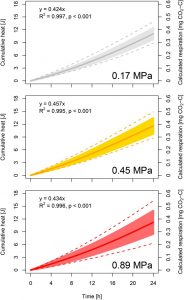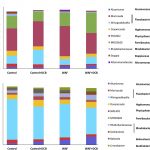Energy Costs of Root Growth
The energy costs of root growth are particularly high in dry and compacted soil because soil penetration resistance increases under these conditions. As a result, more photosynthate is needed for root system expansion, leaving less carbon available for aboveground plant growth. Furthermore, the growth rates of roots decrease with increasing penetration resistance, resulting in limited and delayed access to soil resources. In t his study, Colombi et al. (10.1104/pp.19.00262) examined the utility of root cortical cell diameter as a potential selection target to reduce the energy costs of root growth. Isothermal calorimetry, which measures heat dissipation non-destructively, was used to determine the energy costs of root growth in 16 wheat (Triticum aestivum) genotypes under three levels of penetration resistance. A combination of heat dissipation measurements and root anatomical data allowed the authors to relate the energy costs of root growth to genotypic diversity and phenotypic plasticity in root cortical cell diameter. The results of these studies revealed that cortical cell diameter is especially closely related to the energy costs of root growth. Genotypic diversity was found for cortical cell diameter and the energy costs of root growth. A large root cortical cell diameter correlated with reduced energy costs of root growth, particularly under high soil penetration resistance. Moreover, significant correlations were found between the ability to radially enlarge cortical cells upon greater penetration resistance (i.e. phenotypic plasticity) and the responsiveness in the energy costs of root growth. A higher degree of phenotypic plasticity in cortical cell diameter was associated with reduced energy costs of root growth as soil penetration resistance increased. Genotypic diversity and phenotypic plasticity in cortical cell diameter could be useful for producing crops that are better adapted to dry and compacted soils.
his study, Colombi et al. (10.1104/pp.19.00262) examined the utility of root cortical cell diameter as a potential selection target to reduce the energy costs of root growth. Isothermal calorimetry, which measures heat dissipation non-destructively, was used to determine the energy costs of root growth in 16 wheat (Triticum aestivum) genotypes under three levels of penetration resistance. A combination of heat dissipation measurements and root anatomical data allowed the authors to relate the energy costs of root growth to genotypic diversity and phenotypic plasticity in root cortical cell diameter. The results of these studies revealed that cortical cell diameter is especially closely related to the energy costs of root growth. Genotypic diversity was found for cortical cell diameter and the energy costs of root growth. A large root cortical cell diameter correlated with reduced energy costs of root growth, particularly under high soil penetration resistance. Moreover, significant correlations were found between the ability to radially enlarge cortical cells upon greater penetration resistance (i.e. phenotypic plasticity) and the responsiveness in the energy costs of root growth. A higher degree of phenotypic plasticity in cortical cell diameter was associated with reduced energy costs of root growth as soil penetration resistance increased. Genotypic diversity and phenotypic plasticity in cortical cell diameter could be useful for producing crops that are better adapted to dry and compacted soils.



